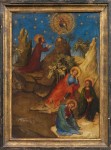 Conservators at Madrid’s Prado Museum have uncovered a rare portrait of Louis I, Duke of Orléans, son of Charles V of France and brother of Charles VI, hidden under overpaint in The Agony in the Garden, a 15th-century French painting depicting Jesus praying in the Garden of Gethsemane while Peter, John and James slumber. The museum first encountered the work in February of 2011, when the private owner offered it to the Prado for study and potential acquisition. The lab gave it the full analytical monty: ultraviolet photography, X-rays, Infra-red reflectography, tests on the pigments and the panel.
Conservators at Madrid’s Prado Museum have uncovered a rare portrait of Louis I, Duke of Orléans, son of Charles V of France and brother of Charles VI, hidden under overpaint in The Agony in the Garden, a 15th-century French painting depicting Jesus praying in the Garden of Gethsemane while Peter, John and James slumber. The museum first encountered the work in February of 2011, when the private owner offered it to the Prado for study and potential acquisition. The lab gave it the full analytical monty: ultraviolet photography, X-rays, Infra-red reflectography, tests on the pigments and the panel.
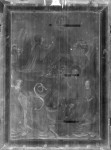 They found that the painting was an extremely high quality piece. The pigments contain large amounts of expensive lapis lazuli painted on a Baltic oak panel. Tree ring analysis of the oak indicated the tree was felled in 1382. The X-rays and Infra-red reflectography revealed the artist had painted two figures on the bottom left which were later painted over with a thick layer of brown. The standing figure is clearly a saint, identified by the lamb at her feet as Saint Agnes. At her feet, a male figure kneels holding a scroll and looking at the scene in the garden. The man is dressed in sumptuous clothes that were fashionable around 1400. According to painterly convention, his posture and position indicates that he was included in the painting because he or his family commissioned the work.
They found that the painting was an extremely high quality piece. The pigments contain large amounts of expensive lapis lazuli painted on a Baltic oak panel. Tree ring analysis of the oak indicated the tree was felled in 1382. The X-rays and Infra-red reflectography revealed the artist had painted two figures on the bottom left which were later painted over with a thick layer of brown. The standing figure is clearly a saint, identified by the lamb at her feet as Saint Agnes. At her feet, a male figure kneels holding a scroll and looking at the scene in the garden. The man is dressed in sumptuous clothes that were fashionable around 1400. According to painterly convention, his posture and position indicates that he was included in the painting because he or his family commissioned the work.
Conservators could not identify the kneeling figure from the X-rays. The pattern on his sleeves was a likely clue — they could be a family emblem — but it wasn’t clear what they were. Saint Agnes was another clue. She takes a protective posture in the painting so could be the patron saint of the man kneeling in front of her. Researchers looked for someone in the upper ranks of French nobility with a connection to Saint Agnes and Louis of Orléans came up. Agnes was the patron saint both of his father King Charles V, to whom he was devoted, and of his wife Valentina Visconti, daughter of the Duke of Milan.
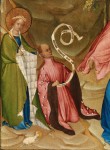 There are only three extant portraits of Louis, all of them manuscript illuminations. If the Donor could be confirmed as Louis of Orléans, this painting would be the only one of him ever found. Restorers decided to attempt to remove the overpainting to reveal the figure if it could be accomplished without damaging the original paint. The top layer was a natural resin varnish, easily removed using a light solvent. There were two layers of overpainting, the most recent applied in the 19th century or later. The overpainting was separated from the original paint by an isolating layer of varnish, but because the original paint is a very fragile egg tempera, it was too risky to use any solvents. Instead, restorers removed the overpaint with scalpel, looking through a stereoscopic microscope at the highest magnification so they could identify non-original pigment not visible to the naked eye.
There are only three extant portraits of Louis, all of them manuscript illuminations. If the Donor could be confirmed as Louis of Orléans, this painting would be the only one of him ever found. Restorers decided to attempt to remove the overpainting to reveal the figure if it could be accomplished without damaging the original paint. The top layer was a natural resin varnish, easily removed using a light solvent. There were two layers of overpainting, the most recent applied in the 19th century or later. The overpainting was separated from the original paint by an isolating layer of varnish, but because the original paint is a very fragile egg tempera, it was too risky to use any solvents. Instead, restorers removed the overpaint with scalpel, looking through a stereoscopic microscope at the highest magnification so they could identify non-original pigment not visible to the naked eye.
Once liberated from their brown prison, the figures were revealed in all their brilliant glory. The colors were far brighter and richer than the colors on the saints and Jesus. The Donor’s scroll was found to be inscribed with the first words of the Psalm 50, aka the Miserere mei. The decorations on the sleeves turned out to be gold nettle leaves and they looked like appliqué rather than a fabric print.
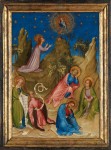 The nettles were the key to the identification of Louis of Orléans. The nettle leaf was one of the duke’s emblems, one he particularly favored from 1399 until his death in 1407. Inventories of his possessions have survived and the 1403 inventory list “LXV feuilles d’or en façon d’orties,” meaning 65 gold leaves in the shape of nettles. He would have used these to decorate his clothes, like the dramatic fur-lined batwing houppelande the Donor wears in the painting.
The nettles were the key to the identification of Louis of Orléans. The nettle leaf was one of the duke’s emblems, one he particularly favored from 1399 until his death in 1407. Inventories of his possessions have survived and the 1403 inventory list “LXV feuilles d’or en façon d’orties,” meaning 65 gold leaves in the shape of nettles. He would have used these to decorate his clothes, like the dramatic fur-lined batwing houppelande the Donor wears in the painting.
Comparisons with the manuscript depictions of Louis support the identification. The distinctive nose and chin are similar in all the images, but his bald pate is only visible in the painting because Louis wears a hat in all three illuminations. He can’t wear a hat in Gethsemane, however, because he’s in the presence of God, Father and Son, no less. That makes this portrait even more remarkable.
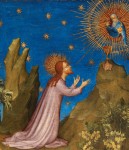 Once Louis’ identity was pinned down, researchers were able to extrapolate from that the possible artist. There are very few surviving panel paintings from this period, and the style and quality of this one is unique so there is no means to devise attribution by comparing techniques. Louis of Orléans had painter in his household. Colart de Laon worked as a painter and as personal valet to the duke from 1391 until Louis’ death. He then did the same work for Louis’ son Charles until 1411. Contemporary sources praise him as one of the most significant artist of the day, but none of his work has been known to survive.
Once Louis’ identity was pinned down, researchers were able to extrapolate from that the possible artist. There are very few surviving panel paintings from this period, and the style and quality of this one is unique so there is no means to devise attribution by comparing techniques. Louis of Orléans had painter in his household. Colart de Laon worked as a painter and as personal valet to the duke from 1391 until Louis’ death. He then did the same work for Louis’ son Charles until 1411. Contemporary sources praise him as one of the most significant artist of the day, but none of his work has been known to survive.
This painting is a small piece, probably intended for a use in a private chapel rather than a large church. The Gethsemane theme and the Miserere mei were usually included in funerary artworks, and since Louis’ family is not included in the panel, it’s likely that it was commissioned by his wife or son after his assassination.
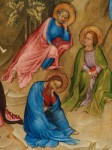 Louis I, Duke of Orléans, Count of Valois, Duke of Touraine, Count of Blois, Angoulême, Périgord, Dreux, and Soissons, regent of France when his older brother Charles VI, aka Charles the Mad, went insane, was assassinated by his cousin and co-regent John the Fearless, Duke of Burgundy. John’s courage against Ottoman forces in the Battle of Nicopolis (1396) earned him his nickname and his bullheaded vanity helped ensure his side was utterly routed. You can read all about it in one of my favorite books of all time, Barbara Tuchman’s A Distant Mirror: The Calamitous 14th Century. Many of these events are covered in Book IV of Jean Froissart’s Chronicles, which sadly I cannot find for free online, but here’s a full version available for 90 cents.
Louis I, Duke of Orléans, Count of Valois, Duke of Touraine, Count of Blois, Angoulême, Périgord, Dreux, and Soissons, regent of France when his older brother Charles VI, aka Charles the Mad, went insane, was assassinated by his cousin and co-regent John the Fearless, Duke of Burgundy. John’s courage against Ottoman forces in the Battle of Nicopolis (1396) earned him his nickname and his bullheaded vanity helped ensure his side was utterly routed. You can read all about it in one of my favorite books of all time, Barbara Tuchman’s A Distant Mirror: The Calamitous 14th Century. Many of these events are covered in Book IV of Jean Froissart’s Chronicles, which sadly I cannot find for free online, but here’s a full version available for 90 cents.
The Prado decided to purchase the painting, needless to say. They cleaned the entire thing, removing the overpaint that had darkened and dulled the rest of the figures and revealing the original brilliant color. The Agony in the Garden is now on display in Room 58A of the Villanueva Building. For more about the painting and restoration, watch these subtitled videos on the Prado’s website.